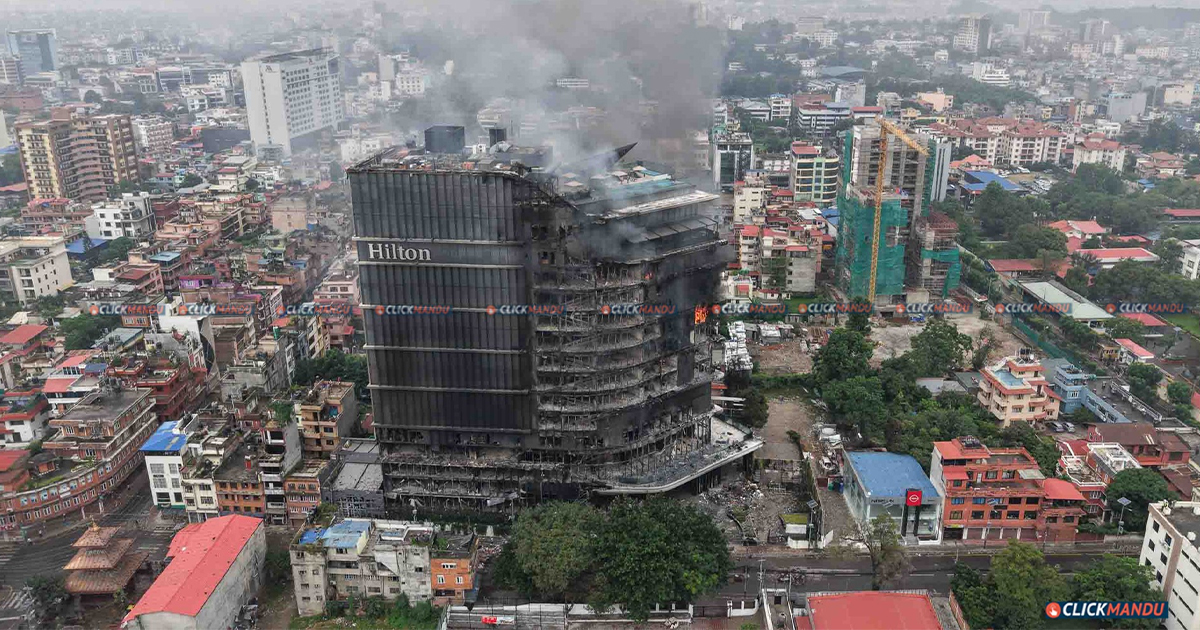Kathmandu: The Gen-Z protests, launched in the name of good governance and other issues, have inflicted irreparable damage on the country. There were some human casualties as well.
The protests saw physical attacks on all three state organs—the executive, the legislature, and the judiciary—as well as on the fourth pillar, the press. Several private properties were also badly damaged. A large number of injured protesters are still undergoing treatment in hospitals.
The demonstrations of September 8 and 9 not only damaged infrastructure and caused human casualties, but also hurt Nepal’s international reputation and its tourism industry, which is a key national identity. The unrest struck just as the tourist season was about to begin, shaking the sector. Many tourism-related infrastructures suffered damage.
Some foreign visitors even canceled their bookings for the upcoming season, creating uncertainty in the tourism sector. Nepal’s tourism, which had only just begun recovering from the 2015 earthquake, the blockade, and the COVID-19 pandemic, was once again jolted.
Still, experts see rays of hope. Since the current crisis is less devastating than past disasters, they believe the sector will gradually recover.
Former Finance Secretary Rameshore Khanal expressed confidence that Nepal’s tourism industry would soon rebound.
“The first thing is, there is no threat to tourists. What we need now is positive publicity, not negative. Unlike past disasters, today’s situation is not as severe. The number of tourists affected by travel advisories is very small. The main source markets remain India and China. The tourist season is about to begin, and only limited infrastructure has been damaged. Trekking, religious, and adventure tourism remain unaffected. This situation will improve quickly,” he said.
Khanal added that since the protests have not heavily impacted remittances, agriculture, and tourism—the three major contributors to the economy—the recovery will not take long.
Economist Dr Samir Khatri also emphasized that despite some damage to infrastructure, tourism remains a sector full of possibilities.
“There is great potential in tourism, though there is some fear that problems at Tribhuvan International Airport could discourage tourists. The government must promote Nepal positively in the international arena,” he said, adding that although earnings might dip temporarily, past experience shows tourism bounces back quickly after crises.
Economist Khatri argued that the Gen-Z protests had also provided Nepal with an opportunity for course correction and had sent a message about building a more accountable society.
Nepal Tourism Board (NTB) CEO Deepak Raj Joshi confirmed that efforts for recovery are already underway.
“We have drafted a recovery plan in consultation with leading organizations in the sector, and this will soon be presented. Based on past experience and with the support of international tourism associations, Nepal will bounce back quickly,” he said.
According to Joshi, around 15,000 foreign tourists are currently in Nepal. While many are traveling across destinations, others are waiting to return home. The board has prioritized ensuring they do not develop negative perceptions of Nepal.
NTB is also studying the extent of damage to hotels and tourism businesses during the Gen-Z protests. Its data shows that 25,500 tourists visited Nepal in September 2025, compared to 88,680 in August. In 2024, Nepal welcomed 1,147,548 visitors, while 2023 saw 1,014,000. The record was set in 2019, with 1,197,191 arrivals.
Hotel Association of Nepal President Binayak Shah stressed the need for unity among all stakeholders to revive the sector.
“With the tourist season about to begin, it is crucial to send positive messages from Nepal. In past crises too, tourism recovered quickly,” he said. Shah highlighted the need to ensure safe travel for current tourists and smooth departures for those returning home.
“Tourism remains the key sector for Nepal’s economic prosperity,” he added. “There has been heavy investment in hotels and airports. With effective management, Nepal can attract more visitors, especially from the two giant neighbours, India and China.”
PATA Nepal Chapter General Secretary Narendra Dev Bhatt also voiced optimism.
“The crisis has indeed had a negative effect during peak tourist season, but we expect conditions to normalize soon and tourism to regain momentum,” he said.
The Nepal Mountaineering Association and Trekking Agencies’ Association of Nepal (TAAN) issued a joint statement urging all-out efforts to keep tourism, Nepal’s global identity, alive. They called for restoring peace and creating a tourism-friendly environment.
The Hotel Association of Nepal reported that nearly two dozen hotels were badly damaged during the Gen-Z protests.
Preliminary data show major hotels—both domestic and international brands—in Kathmandu Valley, Pokhara, Butwal, Bhairahawa, Jhapa, Morang’s Biratnagar, Dhangadhi, Mahottari, and Dang’s Tulsipur faced vandalism, arson, and looting.
In Kathmandu alone, Hilton Hotel is estimated to have suffered damage worth over Rs 8 billion. Across the country, initial estimates put the total losses at more than Rs 25 billion.



Comment Here